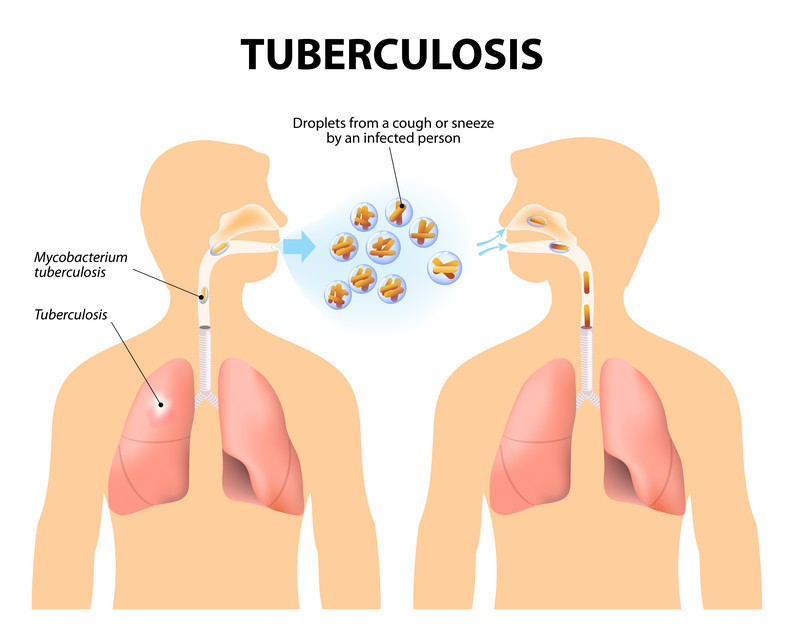Tuberculosis (TB): Symptoms, Causes, Treatment
What are the symptoms of tuberculosis?
Tuberculosis (TB) is a bacterial infection that primarily affects the lungs, but it can also affect other parts of the body. The symptoms of TB can vary depending on the location and severity of the infection. Here are some common symptoms of TB:
Lung TB:
- Coughing: A persistent cough that lasts for three weeks or more, with or without blood or phlegm.
- Chest pain: Pain or discomfort in the chest, which may worsen with coughing.
- Fatigue: Feeling tired or weak.
- Weight loss: Unexplained weight loss.
- Fever: A low-grade fever, usually less than 101°F (38.3°C).
- Coughing up blood: Coughing up blood or rust-colored sputum.
Extrapulmonary TB:
- Swollen lymph nodes: Enlarged lymph nodes in the neck, armpits, or groin.
- Pneumonia-like symptoms: Chest pain, coughing, and fever, similar to pneumonia.
- Bone and joint pain: Pain in the bones, joints, or spine.
- Skin lesions: Lesions or rashes on the skin, which may be painless or painful.
- Neurological symptoms: Headaches, confusion, seizures, or weakness in the legs.
Other symptoms:
- Loss of appetite: Decreased appetite.
- Night sweats: Sweating at night.
- Chills: Feeling cold or shivering.
- Lethargy: Feeling tired or sluggish.
Important note: TB symptoms can be similar to those of other conditions, such as bronchitis, pneumonia, or chronic obstructive pulmonary disease (COPD). If you’re experiencing any of these symptoms, it’s essential to consult a healthcare provider for proper diagnosis and treatment.
In some cases, TB may not cause any symptoms at all, especially in its early stages. This is known as latent TB infection. Latent TB infection is not contagious and can be treated with antibiotics to prevent the development of active TB disease.
If you suspect you have TB or have been exposed to someone with TB, it’s crucial to seek medical attention promptly to prevent the spread of the disease and ensure proper treatment.
What are the causes of tuberculosis?
Tuberculosis (TB) is caused by the bacterium Mycobacterium tuberculosis. TB is a contagious disease that is usually spread through the air when an infected person coughs, sneezes, or talks.
The primary causes of TB transmission include:
- Close contact with an infected person: Breathing in air droplets containing the TB bacteria from a person with active TB disease is the most common way TB is spread.
- Weakened immune system: People with weakened immune systems, such as those with HIV/AIDS, malnutrition, or certain medical conditions, are at a higher risk of developing active TB if they are infected with the bacteria.
- Not completing TB treatment: Not completing the full course of TB treatment can lead to drug-resistant TB, which is more difficult to treat and can be transmitted to others.
- Drug-resistant TB: Drug-resistant strains of TB can develop when TB bacteria are exposed to inadequate treatment, such as when people do not take their medications as prescribed.
- Travel to or from areas with high TB rates: TB is more common in some parts of the world, and travelers to or from these areas may be at higher risk of exposure.
It’s important to note that not everyone infected with TB bacteria develops active TB disease. In many cases, the immune system is able to control the bacteria, leading to latent TB infection. However, latent TB can become active TB disease if the immune system becomes weakened.
What is the treatment for tuberculosis?
The treatment for tuberculosis (TB) depends on whether the TB is active or latent, as well as the drug susceptibility of the TB bacteria. Treatment typically involves a combination of medications that must be taken for several months to effectively kill the bacteria and prevent the development of drug-resistant TB.
- Active TB: Treatment for active TB usually involves a combination of four antimicrobial drugs taken for at least six months. The most common drugs used to treat TB include isoniazid, rifampin, ethambutol, and pyrazinamide. In some cases, depending on the drug susceptibility of the TB bacteria, other drugs may be used.
- Latent TB: Treatment for latent TB involves taking a single drug, usually isoniazid, for several months to kill the bacteria and prevent the development of active TB disease.
It’s important to take all medications exactly as prescribed and to complete the full course of treatment, even if symptoms improve before the medication is finished. Failure to complete the full course of treatment can result in the bacteria becoming resistant to the medications, making TB more difficult to treat.
In addition to medication, people with active TB should take precautions to prevent spreading the disease to others, such as covering their mouth and nose when coughing or sneezing and staying home from work or school until they are no longer contagious.
Regular follow-up with a healthcare provider is important to monitor treatment progress and to ensure that the TB bacteria are being effectively killed.




